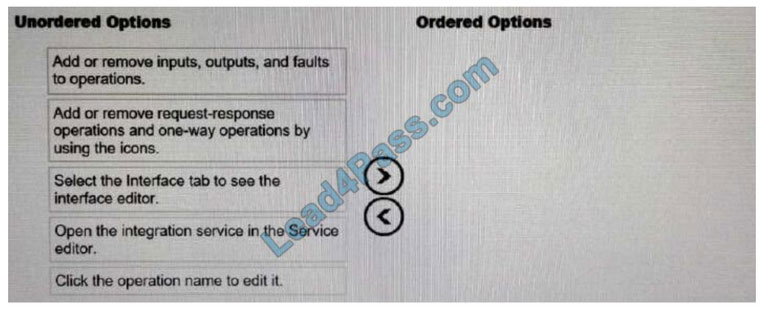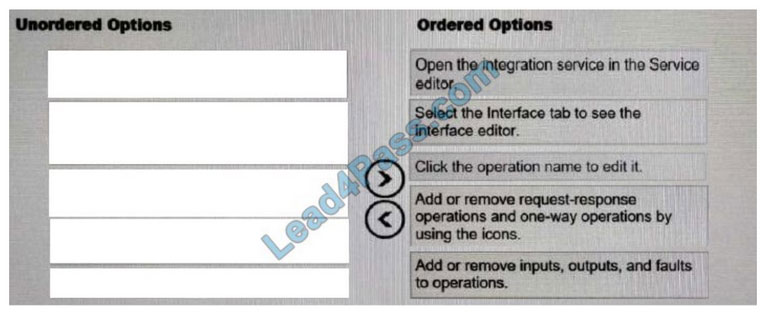C1000-065 IBM Cognos Analytics Developer V11.1.x
IBM
IBM C1000-065 Exam Dumps
IBM C1000-065 Exam Questions
IBM C1000-065 Free Dumps
IBM Certified Developer - Cognos Analytics V11.1.x
c1000-065, c1000-065 dumps, c1000-065 exam questions, IBM Cloud Integration and Development, IBM Cloud Integration and Development c1000-065 exam
admin
0 Comments
IBM Cloud Integration and Development C1000-056 dumps update release [2022]
Earn the Certified IBM Cloud Integration and Development exam to measure and validate the skills of App Connect enterprise solution developers.
Therefore, taking the IBM Cloud Integration and Development C1000-056 exam to become a member of IBM Cloud strongly recommends that you practice all exam content using the C1000-056 dumps: https://www.leads4pass.com/c1000-056.html.
New C1000-056 dumps have been released to ensure you successfully pass the IBM Cloud Integration and Development certification exam on your first attempt.
Practice some of the C1000-056 dumps exam questions online:
[Updated 2022.6] Announce the answer at the end of the article
QUESTION 1:
What are two valid destination options for a Trace node?
A. Events
B. IBM MQ queue
C. File
D. System Trace
E. Local Error Log
QUESTION 2:
The following flow receives order messages on an MQInput node then uses a Compute node to do some processing and sends MQ messages to two warehouses on two different queues.

The compute node routes the message to two MQOutput nodes connected through terminals Out1 and Out using the following ESQL expressions. PROPAGATE TO TERMINAL \’out1; RETURN TRUE;
After deploying the flow, the solution developer noticed that the second queue always receives an empty message. To fix this issue, which ESQL expression lines should be used in the Compute node instead?
A. PROPAGATE TO TERMINAL \’out; PROPAGATE TO TERMINAL \’out\’;
B. PROPAGATE TO TERMINAL \’out1; DELETE NONE-RETURN TRUE;
C. RETURN TRUE DELETE NONE; RETURN TRUE;
D. PROPAGATE TO TERMINAL \’out1; PROPAGATE; RETURN FALSE;
QUESTION 3:
Which editor is the global cache values defined and retrieved from?
A. Graphical Data Mapping
B. Message Flow Mapping
C. Integration Data Mapping
D. Message Data Mapping
QUESTION 4:
When developing RESTful APIs, what is the main purpose of the RESTAsyncRequest node?
A. Allows a REST request to be issued to a REST API and return control to the flow without waiting for a response
B. Allows a REST operation request to be exposed asynchronously and return control to the client without waiting for a response C Allows a REST operation request to be exposed asynchronously and return control to the flow without waiting for a response
C. Allows a REST request to be issued to a SOAP API and return control to the flow without waiting for a response
QUESTION 5:
In Linux, what kind of Syslog messages are reported by IBM App Connect?
A. err, warn, or user
B. err, warn, or info
C. err, alarm, or info
D. err, warn, or user
QUESTION 6:
The image below is an example of which IBM App Connect Toolkit editor?

A. Graphical Data Mapping
B. Message Flow Editor
C. Policy Editor
D. Message Definition
QUESTION 7:
When sharing data between a calling flow and a response flow, how can use context data be stored?
A. By setting a value in the Environment.CallableFlow.UserContext environment variable
B. On a database or in a local drive
C. In a remote database or in the local host\’s memory
D. By setting a value in the ContextData environment variable or in a local drive
QUESTION 8:
Which command creates basic user credentials to allow logging into the web user interface?
A. mqsiwebaceuseradmin
B. mqsiacldwebuseradmin
C. mqsiwebuseradmin
D. mqsiuseradmin
QUESTION 9:
Which statement is true regarding the RESTAsyncResponse node?
A. It can be in a different integration node as the RESTAsyncRequest node
B. It has to be in the same integration server as the RESTAsyncRequest node
C. It can be in a separate integration server than the RESTAsyncRequest node
D. It has to be in the same flow as the RESTAsyncRequest node
QUESTION 10:
DRAG DROP
What is the correct sequence of steps to define the operations in a service interface?
Select and Place:

Correct Answer:

QUESTION 11:
What is the difference between using Convert Single Project and Convert Multiple Projects when converting from projects to applications and libraries?
A. Convert Single Project is for one existing project and Convert Multiple Projects is for one or more existing projects.
B. Convert Single Project is for converting an existing project and any references into one application while Convert Multiple Projects will convert into multiple desired applications with shared libraries.
C. Convert Single Project will put all artifacts into one application or library, while Convert Multiple Projects will create a new application or library for each existing project.
D. Only Convert Single Projects can convert existing Message Broker projects into IBM App Connect Enterprise applications and libraries, Convert Multiple Projects requires the projects to meet IBM Integration Bus standards before converting.
QUESTION 12:
How can static library LIB1 be converted into a shared library without breaking references?
A. Use the shared library conversion tool from the Integration Toolkit
B. Highlight the static library, open convert wizard create a new shared library selecting the resolve references checkbox which will update all applications, libraries, and independent resources that referenced LIB1.
C. Create a new shared library named TMP1, move all assets from the static library, rename the static library, and rename the shared library LIB1.
D. Export static library LIB1 as a shared library, import the new shared library into the workspace replacing static library with new shared LIB1.
QUESTION 13:
What are two methods for configuring a Highly Available IBM App Connect Enterprise installation?
A. A Microsoft Cluster Server
B. Multi-instance integration nodes with IBM MQ
C. Network deployment mode
D. Integration node clustering
E. High Availability mode
……
Announcement of answers to C1000-056 exam questions:
| Number: | Answers: | Explain: |
| Q1 | CE | |
| Q2 | D | |
| Q3 | A | |
| Q4 | A | You can use a RESTAsyncRequest node in a message flow to issue a REST request to an external REST API, and return control to the flow without waiting for a response. The response is received by a RESTAsyncResponse node, which can be in a separate message flow but must be in the same integration server. The nodes are used as a pair, and correlate responses against the original requests by using a unique identifier, which is specified on both nodes. https://www.ibm.com/support/knowledgecenter/SSMKHH_10.0.0/com.ibm.etools.mft.doc/bz90920 _.html |
| Q5 | B | |
| Q6 | A | |
| Q7 | A | To store user context data, you can either set a value in the Environment.CallableFlow.UserContext environment variable, or create and populate child folders below it in the message tree. For example, you can use the following command to specify context data to be stored in the environment: SET Environment.CallableFlow.UserContext = \’myData\’; |
| Q8 | A | |
| Q9 | D | |
| Q10 | IMG | |
| Q11 | D | |
| Q12 | D | |
| Q13 | AE |
[Google Drive] Download the above C1000-056 dumps exam questions: https://drive.google.com/file/d/1N28kHza8FbwswUmt4GdshSaWeIIUR0B5/
Download leads4pass C1000-056 dumps: https://www.leads4pass.com/c1000-056.html Practice 62 complete IBM Cloud Integration and Development C1000-056 exam questions to prepare you for passing the IBM Cloud Integration and Development exam.
